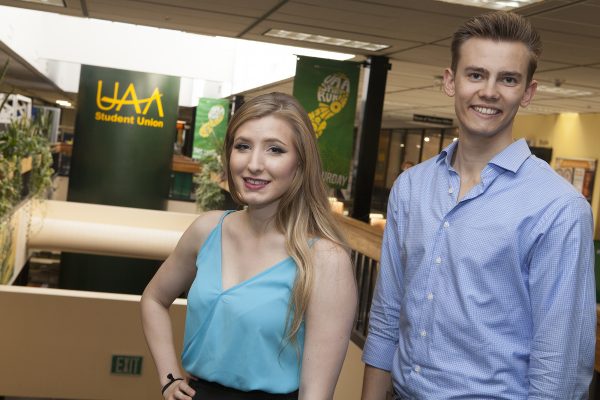Q-and-A: USUAA leaders Samuel Erickson and Johanna Richter
by Tracy Kalytiak |

Johanna Richter, left, and Sam Erickson are serving as (respectively) USUAA's vice president and president. Students elected them in the spring. (Photo by Philip Hall / University of Alaska Anchorage)
What have been the most rewarding or surprising things you have experienced while taking part in student government and/or other UAA activities? The most rewarding experiences we have had with student government tend to be the responses from administrators or state-level officials when we produce a major piece of legislation or offer insightful comments on a specific proposal. The recognition that those efforts produce is quite satisfying on a personal level, but also because it builds the reputation of the organization and increases the likelihood that we will be consulted in the future.
What challenges have you faced and how have you confronted or adapted to those challenges? One of the major challenges we faced was a low returning membership at the beginning of the year. Only half of our senator positions were filled at the start of the year, and we had only two returning delegates out of a potential twelve. To address this, we immediately began recruiting aggressively online, through personal networks and at campus events like Goosefest and Kickoff. These efforts have paid off, as we now have all but one senator position, and four more delegates sworn in. Sometimes, the best way to tackle major problems is simply to take them head on.
What are the most effective ways you have found to engage with students here at UAA? UAA's student population is very unique, and our high commuter population and low residential population means it can be more difficult to reach students who only come to campus for class. In general, that means that the most effective forms of outreach tend to be online, via social media or email, and personal, through human networks and word-of-mouth. We rely heavily on our Facebook page and our individual members to promote events to friends and acquaintances.
Which students are more difficult to reach and engage? The most difficult-to-reach students are often employed commuters, who spent very little time on campus and almost all of it in class, but it can also be difficult to get in contact with siloed students-that is, history majors who spent all their time in the Admin/SSB, business students who live in RH, and so on. One of the disadvantages of UAA's spread-out campus is that many students can go a whole semester without walking through the Student Union or other common spaces.
What ideas have you been able to glean from student government leaders at other campuses about creating a more efficient and satisfying and safe student experience for people here at UAA? The different areas of Alaska and their unique identities are certainly a source of varying ideas, and we've certainly learned a lot since taking the job. In particular we admire Southeast's commitment to programs that serve the entire state such as their online MPA and the legislative internship program, which they have been fighting to resurrect from the large cut it received. USUAS has really provided a great example of always advocating for programs and never giving up. ASUAF in Fairbanks also does a great job in their outreach to students in regards to social and athletics events; we've certainly been studying up on their social media presence and attempting to match their consistency in updating.
Compiled by Tracy Kalytiak, UAA Office of University Advancement
 "Q-and-A: USUAA leaders Samuel Erickson and Johanna Richter" is licensed under a Creative Commons Attribution-NonCommercial 4.0 International License.
"Q-and-A: USUAA leaders Samuel Erickson and Johanna Richter" is licensed under a Creative Commons Attribution-NonCommercial 4.0 International License.














